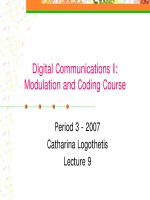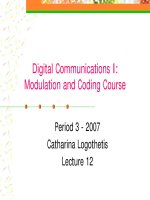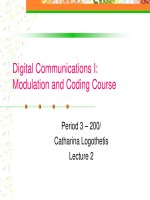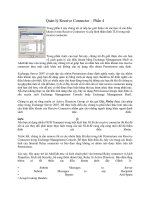Tài liệu Modulation and coding course- lecture 4 pdf
Bạn đang xem bản rút gọn của tài liệu. Xem và tải ngay bản đầy đủ của tài liệu tại đây (139.41 KB, 23 trang )
Digital Communications I: Modulation
and Coding Course
Period 3 - 2007
Catharina Logothetis
Lecture 4
Lecture 4 2
Last time we talked about:
Receiver structure
Impact of AWGN and ISI on the transmitted
signal
Optimum filter to maximize SNR
Matched filter receiver and Correlator receiver
Lecture 4 3
Receiver job
Demodulation and sampling:
Waveform recovery and preparing the received
signal for detection:
Improving the signal power to the noise power (SNR)
using matched filter
Reducing ISI using equalizer
Sampling the recovered waveform
Detection:
Estimate the transmitted symbol based on the
received sample
Lecture 4 4
Receiver structure
Frequency
down-conversion
Receiving
filter
Equalizing
filter
Threshold
comparison
For bandpass signals
Compensation for
channel induced ISI
Baseband pulse
(possibly distored)
Sample
(test statistic)
Baseband pulse
Received waveform
Step 1 – waveform to sample transformation
Step 2 – decision making
)(tr
)(Tz
i
m
ˆ
Demodulate & Sample Detect
Lecture 4 5
Implementation of matched filter receiver
⎥
⎥
⎥
⎦
⎤
⎢
⎢
⎢
⎣
⎡
M
z
z
M
1
z=
)(tr
)(
1
Tz
)(
*
1
tTs −
)(
*
tTs
M
−
)(Tz
M
z
Matched filter output:
Observation
vector
Bank of M matched filters
)()( tTstrz
i
i
−∗=
∗
Mi , ,1
=
), ,,())(), ,(),((
2121 MM
zzzTzTzTz
=
=z
Lecture 4 6
Implementation of correlator receiver
dttstrz
i
T
i
)()(
0
∫
=
∫
T
0
)(
1
ts
∗
∫
T
0
)(ts
M
∗
⎥
⎥
⎥
⎦
⎤
⎢
⎢
⎢
⎣
⎡
M
z
z
M
1
z=
)(tr
)(
1
Tz
)(Tz
M
z
Correlators output:
Observation
vector
Bank of M correlators
), ,,())(), ,(),((
2121 MM
zzzTzTzTz
=
=z
Mi , ,1
=
Lecture 4 7
Today, we are going to talk about:
Detection:
Estimate the transmitted symbol based on the
received sample
Signal space used for detection
Orthogonal N-dimensional space
Signal to waveform transformation and vice versa
Lecture 4 8
Signal space
What is a signal space?
Vector representations of signals in an N-dimensional
orthogonal space
Why do we need a signal space?
It is a means to convert signals to vectors and vice versa.
It is a means to calculate signals energy and Euclidean
distances between signals.
Why are we interested in Euclidean distances between
signals?
For detection purposes: The received signal is transformed to
a received vectors. The signal which has the minimum
distance to the received signal is estimated as the transmitted
signal.
Lecture 4 9
Schematic example of a signal space
),()()()(
),()()()(
),()()()(
),()()()(
212211
323132321313
222122221212
121112121111
zztztztz
aatatats
aatatats
aatatats
=⇔+=
=⇔+=
=⇔+=
=
⇔
+
=
z
s
s
s
ψψ
ψψ
ψψ
ψ
ψ
)(
1
t
ψ
)(
2
t
ψ
),(
12111
aa
=
s
),(
22212
aa
=
s
),(
32313
aa=s
),(
21
zz
=
z
Transmitted signal
alternatives
Received signal at
matched filter output
Lecture 4 10
Signal space
To form a signal space, first we need to know
the inner product
between two signals
(functions):
Inner (scalar) product:
Properties of inner product:
∫
∞
∞−
>=< dttytxtytx )()()(),(
*
= cross-correlation between x(t) and y(t)
>
<
>=< )(),()(),( tytxatytax
><>=< )(),()(),(
*
tytxataytx
>
<
+
>>=<+< )(),()(),()(),()( tztytztxtztytx
Lecture 4 11
Signal space …
The distance in signal space is measure by calculating
the norm.
What is norm?
Norm of a signal:
Norm between two signals:
We refer to the norm between two signals as the
Euclidean distance
between two signals.
x
Edttxtxtxtx ==><=
∫
∞
∞−
2
)()(),()(
)()( txatax =
)()(
,
tytxd
yx
−=
= “length”of x(t)
Lecture 4 12
Example of distances in signal space
)(
1
t
ψ
)(
2
t
ψ
),(
12111
aa
=
s
),(
22212
aa
=
s
),(
32313
aa=s
),(
21
zz=z
zs
d
,
1
zs
d
,
2
zs
d
,
3
The Euclidean distance between signals z(t) and s(t):
3,2,1
)()()()(
2
22
2
11,
=
−+−=−=
i
zazatztsd
iiizs
i
1
E
3
E
2
E
Lecture 4 13
Orthogonal signal space
N-dimensional orthogonal signal space is characterized by
N linearly independent functions called basis
functions. The basis functions must satisfy the orthogonality
condition
where
If all , the signal space is orthonormal.
{}
N
j
j
t
1
)(
=
ψ
jiij
T
iji
Kdttttt
δψψψψ
=>=<
∫
)()()(),(
*
0
Tt
≤
≤
0
Nij , ,1,
=
⎩
⎨
⎧
≠→
=→
=
ji
ji
ij
0
1
δ
1=
i
K
Lecture 4 14
Example of an orthonormal bases
Example: 2-dimensional orthonormal signal space
Example: 1-dimensional orthonornal signal space
1)()(
0)()()(),(
0)/2sin(
2
)(
0)/2cos(
2
)(
21
2
0
121
2
1
==
=>=<
⎪
⎪
⎩
⎪
⎪
⎨
⎧
<≤=
<≤=
∫
tt
dttttt
TtTt
T
t
TtTt
T
t
T
ψψ
ψψψψ
πψ
πψ
Tt
)(
1
t
ψ
T
1
0
)(
1
t
ψ
)(
2
t
ψ
0
1)(
1
=t
ψ
)(
1
t
ψ
0
Lecture 4 15
Signal space …
Any arbitrary finite set of waveforms
where each member of the set is of duration T, can be
expressed as a linear combination of N orthonogal
waveforms
where .
where
{
}
M
i
i
ts
1
)(
=
{}
N
j
j
t
1
)(
=
ψ
MN
≤
∑
=
=
N
j
jiji
tats
1
)()(
ψ
Mi , ,1
=
MN
≤
dttts
K
tts
K
a
T
ji
j
ji
j
ij
)()(
1
)(),(
1
0
*
∫
>=<=
ψψ
Tt
≤
≤
0
Mi , ,1=
Nj , ,1=
), ,,(
21 iNiii
aaa=s
2
1
ij
N
j
ji
aKE
∑
=
=
Vector representation of waveform
Waveform energy
Lecture 4 16
Signal space …
∑
=
=
N
j
jiji
tats
1
)()(
ψ
), ,,(
21 iNiii
aaa
=
s
⎥
⎥
⎥
⎦
⎤
⎢
⎢
⎢
⎣
⎡
iN
i
a
a
M
1
)(
1
t
ψ
)(t
N
ψ
1i
a
iN
a
)(ts
i
∫
T
0
)(
1
t
ψ
∫
T
0
)(t
N
ψ
⎥
⎥
⎥
⎦
⎤
⎢
⎢
⎢
⎣
⎡
iN
i
a
a
M
1
m
s
=
)(ts
i
1i
a
iN
a
m
s
Waveform to vector conversion Vector to waveform conversion
Lecture 4 17
Example of projecting signals to an
orthonormal signal space
),()()()(
),()()()(
),()()()(
323132321313
222122221212
121112121111
aatatats
aatatats
aatatats
=⇔+=
=⇔+=
=
⇔
+
=
s
s
s
ψψ
ψψ
ψ
ψ
)(
1
t
ψ
)(
2
t
ψ
),(
12111
aa
=
s
),(
22212
aa
=
s
),(
32313
aa=s
Transmitted signal
alternatives
dtttsa
T
jiij
)()(
0
∫
=
ψ
Tt
≤
≤
0
Mi , ,1=
Nj , ,1
=
Lecture 4 18
Signal space – cont’d
To find an orthonormal basis functions for a given
set of signals, Gram-Schmidt procedure can be
used.
Gram-Schmidt procedure:
Given a signal set , compute an orthonormal basis
1. Define
2. For compute
If let
If , do not assign any basis function.
1. Renumber the basis functions such that basis is
This is only necessary if for any i in step 2.
Note that
{
}
M
i
i
ts
1
)(
=
{
}
N
j
j
t
1
)(
=
ψ
)(/)(/)()(
11111
tstsEtst ==
ψ
Mi , ,2=
∑
−
=
><−=
1
1
)()(),()()(
i
j
jjiii
tttststd
ψψ
0)( ≠td
i
)(/)()( tdtdt
iii
=
ψ
0)( =td
i
{}
)(), ,(),(
21
ttt
N
ψ
ψ
ψ
0)(
=
td
i
MN ≤
Lecture 4 19
Example of Gram-Schmidt procedure
Find the basis functions and plot the signal space for the following
transmitted signals:
Using Gram-Schmidt procedure:
Tt
)(
1
ts
Tt
)(
2
ts
)( )(
)()(
)()(
21
12
11
AA
tAts
tAts
−==
−=
=
ss
ψ
ψ
)(
1
t
ψ
-A A
0
1
s
2
s
T
A
T
A−
0
0
Tt
)(
1
t
ψ
T
1
0
0)()()()(
)()()(),(
/)(/)()(
)(
122
0
1212
1111
0
2
2
11
=−−=
−=>=<
==
==
∫
∫
tAtstd
Adtttstts
AtsEtst
AdttsE
T
T
ψ
ψψ
ψ
1
2
Lecture 4 20
Implementation of matched filter receiver
)(tr
1
z
)(
1
tT −
∗
ψ
)( tT
N
−
∗
ψ
N
z
Observation
vector
Bank of N matched filters
)()( tTtrz
jj
−
∗=
ψ
Nj , ,1
=
), ,,(
21 N
zzz=z
∑
=
=
N
j
jiji
tats
1
)()(
ψ
MN
≤
Mi , ,1
=
⎥
⎥
⎥
⎦
⎤
⎢
⎢
⎢
⎣
⎡
N
z
z
1
z=
z
Lecture 4 21
Implementation of correlator receiver
), ,,(
21 N
zzz=z
Nj , ,1
=
dtttrz
j
T
j
)()(
0
ψ
∫
=
∫
T
0
)(
1
t
ψ
∫
T
0
)(t
N
ψ
⎥
⎥
⎥
⎦
⎤
⎢
⎢
⎢
⎣
⎡
N
r
r
M
1
z
=
)(tr
1
z
N
z
z
Bank of N correlators
Observation
vector
∑
=
=
N
j
jiji
tats
1
)()(
ψ
Mi , ,1
=
MN
≤
Lecture 4 22
Example of matched filter receivers using
basic functions
Number of matched filters (or correlators) is reduced by 1 compared to using
matched filters (correlators) to the transmitted signal.
Tt
)(
1
ts
Tt
)(
2
ts
Tt
)(
1
t
ψ
T
1
0
[]
1
z
z
=
)(tr
z
1 matched filter
Tt
)(
1
t
ψ
T
1
0
1
z
T
A
T
A−
0
0
Lecture 4 23
White noise in orthonormal signal space
AWGN n(t) can be expressed as
)(
~
)(
ˆ
)( tntntn
+
=
Noise projected on the signal space
which impacts the detection process.
Noise outside on the signal space
>=< )(),( ttnn
jj
ψ
0)(),(
~
>=< ttn
j
ψ
)()(
ˆ
1
tntn
N
j
jj
∑
=
=
ψ
Nj , ,1
=
Nj , ,1
=
Vector representation of
), ,,(
21 N
nnn
=
n
)(
ˆ
tn
independent zero-mean
Gaussain random variables with
variance
{}
N
j
j
n
1=
2/)var(
0
Nn
j
=









